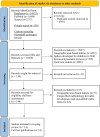Individual-based socioeconomic vulnerability and deprivation indices: a scoping review
- PMID: 39206009
- PMCID: PMC11349641
- DOI: 10.3389/fpubh.2024.1403723
Individual-based socioeconomic vulnerability and deprivation indices: a scoping review
Abstract
Several individual-based social deprivation and vulnerability indices have been developed to measure the negative impact of low socioeconomic status on health outcomes. However, their variables and measurable characteristics have not been unequivocally assessed. A comprehensive database literature scoping review was performed to identify all individual-based social deprivation and vulnerability indices. Area-based indices and those developed for pediatric populations were excluded. Data were extracted from all eligible studies and their methodology was assessed with quality criteria. A total of 14 indices were identified, of which 64% (9/14) measured social deprivation and 36% (5/14) measured socioeconomic vulnerability. Sum of weights was the most common scoring system, present in 43% (6/14) of all indices, with no exclusive domains to either vulnerability or deprivation indices. A total of 83 different variables were identified; a very frequent variable (29%; 5/14) related to an individual's social relationships was "seen any family or friends or neighbors." Only five deprivation indices reported a specific internal consistency measure, while no indices reported data on reproducibility. This is the first scoping review of individual-based deprivation and vulnerability indices, which may be used interchangeably when measuring the impact of SES on health outcomes.
Keywords: deprivation; health inequalities; index; socioeconomic status; socioeconomic vulnerability.
Copyright © 2024 Palermos, Pavi, Halvatsiotis, Mangoulia, Sergentanis and Psaltopoulou.
Conflict of interest statement
The authors declare that the research was conducted in the absence of any commercial or financial relationships that could be construed as a potential conflict of interest.
Figures
References
-
- Zimmermann A. Social Vulnerability as an Analytical Perspective, Berlin, Germany: Population Europe Secretariat; (2017).
Publication types
MeSH terms
LinkOut - more resources
Full Text Sources


